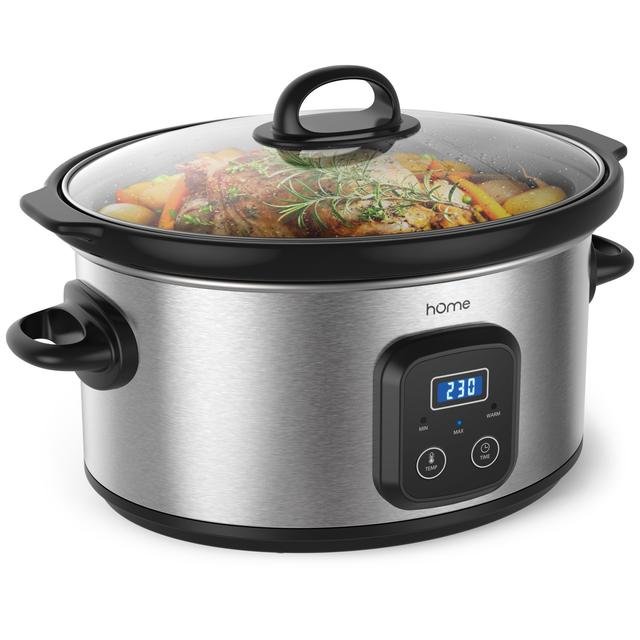
Slow Cookers: Tips and Tricks
A little history lesson? The Crock Pot made its way onto the scene in the early 70’s and gave homemakers a little more freedom than they’d had before with the time it saved them in the kitchen. In the 80’s, busy people started to favor take-out, but they made a comeback at the turn of the century as the Slow Food movement garnered more and more fans. 50 years later, this handy electric countertop braiser is so popular that it’s estimated that over 100 million homes have one.
The slow cooker can serve delicious soups, stews, and delicious roasts with little effort while saving time in the kitchen. Here are a few things you should know to make the most out of your slow cooker or crock pot!
Oval or Round?
The ideal slow cooker crock should be shaped like an oval. Why? The elongation of the oval means that a greater variety of meat cuts will fit. (How many times have you discovered that your round shaped crock pot just wasn’t big enough?) Other foods do well in the oval shape because it allows the ingredients to spread out and cook more evenly. Your best bet? 6 quart (or something anywhere from the 5-7 quart range) is the most convenient size for most dishes, but when in doubt, choose the larger size as opposed to something small. For instance, the itty-bitty 1.5 quart slow cookers are cute but really are best for keeping dips and sauces warm.
Space
After you’ve selected the right size slow cooker, make sure it is at least half full because you don’t want your food to burn or dry out. But also make sure it’s not more than two-thirds full as some foods may expand. You’ll need room for the steam to move about anyways.
Wrong Size Crock Pot
What if you only have a larger sized crock pot or slow cooker but only need to make a small amount? Have no regrets! You can put your smaller amount (let’s say for a dip recipe) in a smaller dish and add 2-3 cups of hot water around the dish to create a water bath.
Head Start
Crock pots and slow cookers usually bring food up to a moderate temperature then maintain it for a long period of braising time, as it’s not an appliance typically known for speed. However, you can help the process along by bringing water or broth to a boil before adding it to the vessel. This method can also help any starches cook more evenly too.
Beef and Pork
What are the best meats for slow cooking? Tough cuts with a lot of connective tissue. The long braising process can transform more budget-friendly cuts of meat. Try beef brisket, chuck roast, or beef round. Pork butt, pork or lamb shoulder is also tasty as well. Browning your meat of choice on the stove before adding it to the crock yields in a richer, heartier flavor for not just the meat, but the gravy and sauces too.
With larger cuts of meat, add your vegetables to the bottom of the cooker first, then add the meat on top. You can also use kitchen twine to tie a beef roast or pork butt into a more even shape to ensure even cooking.
Poultry
When it comes to poultry, slow and low is the way to go! A high temperature and slow braise will actually dry out and toughen your turkey or chicken, especially the white meat. For Boneless, skinless chicken breasts, cook it on low for no more than 2 hours. Turkey breasts can be cooked on low for no more than 6 hours.
Spice It Up
Slow cooking is lengthy process (hence, the name) and it’s important to remember to start with plenty of aromatics and spices, as the long cooking times can also dull flavors. Add dry spices in the beginning and fresh herbs in the end. Most slow cooker recipes call for heavier spices but don’t be scared off by extra garlic or oregano. Add vinegar, fresh herbs or citrus juice right at the end before you serve your dish.
Put a Lid On It
Slow cookers don’t have tightly sealed lids, which is perfectly fine – otherwise, you’d have a pressure cooker! The steam built up over the many hours of cooking should also slowly find its way out. Fight the urge to lift the lid to check on your food because while it takes a second to check, it takes a long time for the heat to build up in the cooker.
Vegetables
Dense vegetables such as carrots and sweet potatoes take longer to cook than other vegetables such as spinach or zucchini. These delicate veggies will turn mushy fairly quickly. Cut your dense vegetables into same sized pieces. Other vegetables like peppers can be stirred into the last 15 minutes while spinach can be added moments before serving.
Getting Saucy
The braising liquid left after the roast is cooked tastes delicious. Don’t let it go to waste. Skim any fat from the surface and season with fresh herbs, citrus juices, or vinegar. You can also take this liquid and puree with some of the cooked vegetables in a blender or in a bowl with an immersion stick blender to create a richer sauce.














